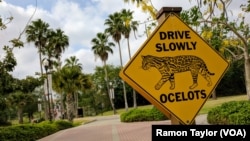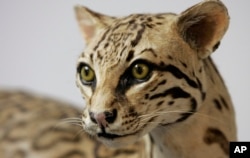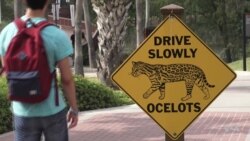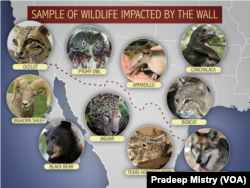Strolling through campus at the University of Texas Rio Grande Valley (UTRGV), you will notice a vivid black-and-yellow sign: “Drive slowly. Ocelots.”
Don’t be fooled. You are unlikely to see an ocelot anywhere on campus or anywhere else in the country. While the striped-and-spotted wild cat was a former school mascot, it is also a federal endangered species. Biologists have estimated there are fewer than 50 remaining in the U.S., almost all of them in Texas.
Build a wall along the border with Mexico, and that number is likely to decrease further because the pool of U.S. ocelots has shrunk to the point where the elusive, territorial animals — ocelots range up to 90 square km — are inbreeding, weakening a population that is already suffering from loss of habitat.
Ocelots’ best hope
The U.S. Fish and Wildlife Service’s (FWS) best hope to save the ocelot is to connect the waning population in Texas to a larger one in Mexico “to provide a migratory corridor and expand the gene pool,” FWS writes on its website.
But the ocelot’s needs are at odds with imperatives to secure the border.
“The [Bush-era] wall went up; it further fragmented (ocelot) habit,” said Scott Nicol, co-chair of the Sierra Club Borderlands. “More walls go up, they will chop through their habitat yet again … making it even less likely that they are going to survive.”
Watch: Environmentalists Worry Trump’s Wall Will Spell Doom for Border Wildlife
Time running out
In a recent planning document, the Department of Homeland Security named the Rio Grande Valley a high priority area for President Donald Trump’s border wall, because of the high rate of undocumented immigrants entering the U.S. here.
It is also a high priority for conservationists. Only 5 percent of the native habitat remains along the lower Rio Grande, yet FWS says it is home to 1,200 species of native plants, 700 species of vertebrates (including nearly 500 bird species), and 300 species of butterflies.
A wall would be devastating to many of them.
“This is the coup de grâce,” said Dr. Alejandro Fierro, a restoration ecologist and assistant professor at UTRGV. A barrier, he said, could lead to the local population extinction of several species, including the ocelot.
Fierro and Nicol say it’s not just the larger animals that are impacted by barriers, in any forms. An array of plants, birds and ground-dwelling insects, some endangered, could be further impacted if Trump’s wall is built, and especially if it’s made of concrete.
“A concrete barrier would be far worse than a bollard wall,” Nicol said. Seed-dispersers, such as javelinas — also known as skunk pigs — “may eat the fruit of a prickly pear cactus, and they can no longer make it into a chunk of territory and then poop those seeds out. The plant is now being stopped, in the same way that an animal is being stopped.”
‘All it takes is a hurricane’
Nicol walks along a section of the current barrier that separates two popular eco-tourist destinations, the World Birding Center and the Lower Rio Grande Valley National Wildlife Refuge. The fence is north of the actual border because of its location on a flood plain.
The area, he said, is susceptible to flooding, which is why a 32-kilometer portion of the valley’s barrier also serves as a levee, protecting nearby residential areas during tropical storms or hurricanes. But unlike the sloped levee of years past, Nicol said this one has had deadly consequences for smaller terrestrial animals, including the endangered Texas tortoise.
“If you are any kind of terrestrial animal, you’d just go up and over the levee and then you were on dry land,” Nicol said. “If there is a [vertical] concrete slab in your way, you can't do that anymore. That terrain is underwater for two to three or more months. You’ve got no hope.”
Mayor Joel Villarreal of Rio Grande City, one of few remaining border towns in the Rio Grande Valley without a barrier, is not convinced that a new wall itself could withstand the worst of South Texas hurricanes, at least not near his town.
One of the key questions engineers must ask, he said, is whether the geography could allow a wall in the first place.
“In 2011, we had a flood that affected the lives of many individuals,” Villarreal told VOA. “If we would have had the wall at that point, I don’t think [it] would have survived that flood.” For a river to change its trajectory, he added, “all it takes is a hurricane.”
With or without a wall, withstanding a storm becomes a matter of preparedness for the town’s people. But for many other species, the wall itself would be a barrier to survival.









